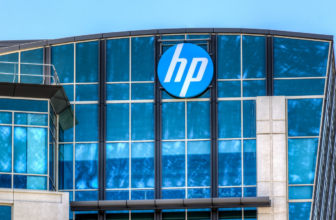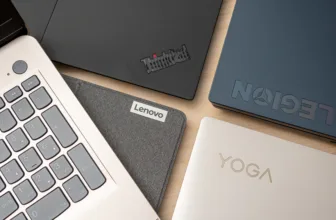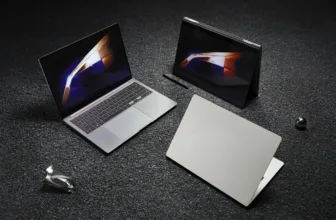The Surface Pro 9 is Microsoft’s latest 2-in-1 device and the third to use the design language introduced with the Surface Pro X. You have a lightweight machine thanks to the magnesium casing, but not so light that it feels fragile.
The Pro 9 uses a reduced bezel size, allowing the 12.3-inch display to dominate the device. Once more, Microsoft has decided on a 3:2 ratio screen which feels far better suited to doing ‘work’ on the move than the 16:9 screens found in more leisure-focused computers. You still have the iconic kickstand, which allows the display to be angled to the best position when in use, and support for the Surface Pen and the detachable Surface keyboard. Both of those remain additional purchases, so the high price of the Surface Pro 9 has – yet again – got a sting in its tail if you need the full experience.
The Surface Pro 9 line-up is a pair of devices. While the Surface range has always offered various levels of Intel processors, the Surface Pro 9 also offers an ARM-based version; we have both the sequel to the Surface Pro 8 and the Surface Pro X.
My review unit is the Intel-based version. This is more suited to tasks that need the extra computing power – video and media editing spring to mind, as well as complex legacy x86 applications. The ARM-based version is geared towards being a highly mobile device with longer battery life and better connectivity. Practically, the Intel-based Pro 9 I’m reviewing can consistently reach the seven-hour mark for battery life with my mixed real-world usage.
Notably, the ARM-based version is the only version to come with 5G connectivity, although it tops out at 16 GB RAM and 512 GB storage… the Intel models go all the way up to 32 GB RAM and 1 TB of storage on the Core i7 model.
How does the Surface Pro 9 work in day-to-day use?
The touch screen is impressive, and with a resolution of 2736 x 1824 pixels, there’s a lot of information on the screen. That’s particularly noticeable when running office-based apps. I’m one for getting as much information on the screen as possible, especially on web pages, and again the expansive display allows that to happen.
I’d also highlight Microsoft’s use of tiling multiple app windows and the ‘preset’ configurations you can quickly switch to. While a lot of the UI furniture still needs to be on display, the larger screen means you don’t miss as much information compared to smaller displays running a 16:9 ratio screen.
As a device for consuming content, the Pro 9 is excellent (albeit expensive). The lightweight and long battery life mean there’s a lot of trust in the machine that, if you grab it and go, it will keep going in your hand. Where it starts to get awkward is creating content. Because with the best will in the world, using your fingers for touch, and the on-screen keyboard for input, is not fast or speedy. It’s convenient in short bursts, but trying to use the naked Surface Pro 9 when the creativity is flowing fast is not pretty.
Microsoft didn’t ship a keyboard or Surface Pen with the review unity, and I was doing my best to look at just the Pro 9, but I’ll be honest… after two weeks, I gave in and popped the Surface Keyboard and Slim Pen from my older Surface Pro X to the Pro 9. At least there’s some backwards compatibility on offer.
The Surface Pro line has been an evolutionary line. There’s rarely been any massive jumps in the offering; everything has been a quiet step up from previous models. Take the inclusion of 5G connectivity on the ARM-based model. That builds on the 4G LTE on the Pro X, which then came over to the Surface Pro 8. The Surface Pen and the accuracy of the touchscreen have both improved over time, with more precision being added to the screen, more features such as pressure sensitivity in the Pen, and a faster experience of inking thanks to the hardware.
There have to be some first steps to start this journey off. For the Surface Pro 9, I’d argue that the integration of ARM into the main Pro line-up is the big step forward, and everything else is a result of the aggressive application of Moore’s Law.
The Surface Pro 9 is competent in the very best definition of the word. It has everything you would expect in a tablet computer – from a large and responsive screen through the lightweight and easy mobility and into secondary features that offer good quality-of life options for the consumers.
The ARM-powered version of the Surface Pro 9 is where I feel Microsoft is pushing the envelope. Not only does it have the advantages of ARM of battery life and portability, it also includes enhanced video calling software, with AI allowing improved audio and visuals.
Would it have been nice for this to be added to the Intel version? Yes, but it’s nowhere close to being a deal-breaker.
Microsoft’s Surface Pro is a versatile line that has worked hard to establish the Windows-based tablet as a viable option for many. Yet the two biggest issues – which are intrinsically linked – remain. The Surface Pro 9 is an expensive option. You are paying a premium to go for a 2-in-1 over a regular laptop. And if you want to unlock the potential of the 2-in-1 you have to pay even more for the keyboard and pen.
What you do get is a powerful, lightweight, and portable computer. The physical design feels reliable and premium; in use, it’s comfortable to use and quick to react; and with both the Microsoft name and the longevity of the Surface Pro brand, there is a feeling of comfort and reliability around the product.









